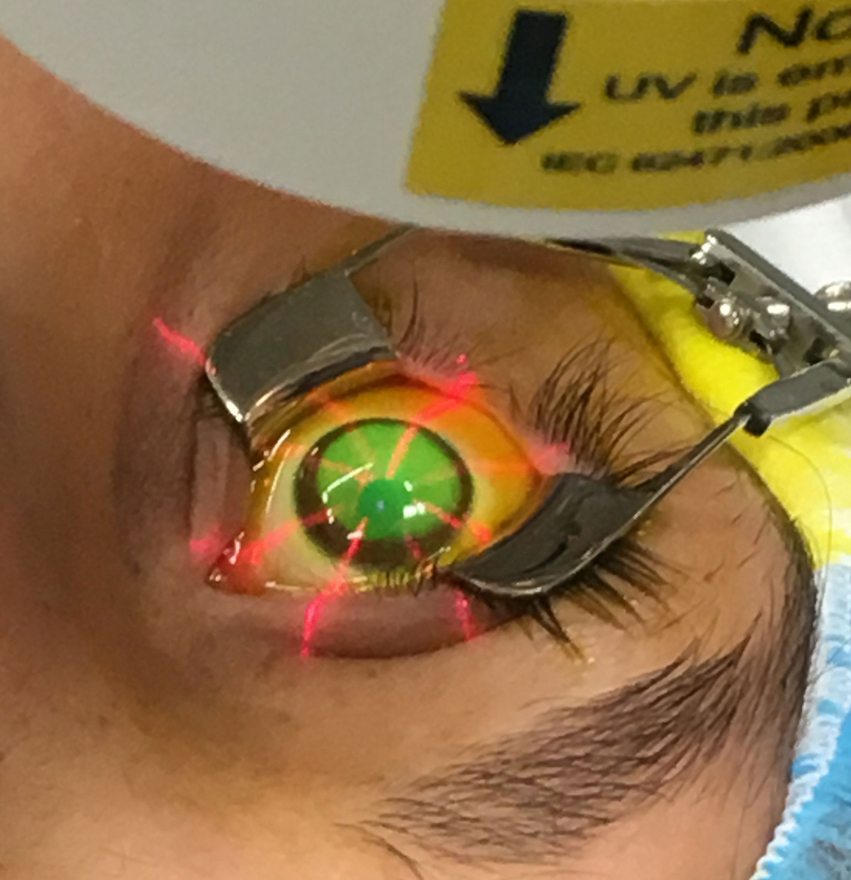 |
| Adverse ocular events after CXL were rare (<5% of cases), but included persistent corneal haze after 12 months, infectious keratitis, sterile corneal infiltrates and epithelial downgrowth under the LASIK flap, as well as loss of corrected distance visual acuity. Photo: Glaukos. Click image to enlarge. |
Optometrists and ophthalmologists in the United States have become quite familiar with, and confident in, corneal collagen crosslinking (CXL) since its FDA approval in 2016, but additional validation and detail is always welcome. In a recent report by the American Academy of Ophthalmology—one of its periodic Ophthalmic Technology Assessment publications—researchers assessed the safety and efficacy of epithelium-off (epi-off) CXL for treating progressive corneal ectasia in keratoconus (KCN) patients and other applications. The findings were published in the Ophthalmology journal on Wednesday.
A literature search on the procedure was done in March 2024 by a panel of 10 ophthalmologists at the behest of the AAO. Out of 359 citations reviewed in abstract form, 43 were reviewed in full text and six were sufficiently relevant to include. Five of these studies were randomized clinical trials comparing epi-off CXL with conservative treatment to treat progressive KCN patients, while one study assessed the procedure’s use in post-laser refractive surgery ectasia. Mean postoperative follow-up was 2.4 years, ranging from one to five total years.
All the included studies found decreased progression rate in those treated with CXL when compared with controls. As well, the treatment groups in these studies saw improvement in the maximum keratometry (Kmax) value and corrected and uncorrected distance visual acuity when compared with control groups. Corneal thickness decrease was observed in both groups but was greater in those who received CXL; complications of the procedure were rare.
From these results, the study authors relay an acceptable safety profile for procedure use in these cases. They further elaborate specific details of the studies. Five of the six studies followed the standard Dresden protocol, while one study used an accelerated protocol. Eyes were randomized as whether to receive CXL or conservative treatment (defined as observation with corrective lenses as needed).
Progression rates in the untreated controls ranged from 14% to 46% vs. just 4% to 12% for the treatment groups, with the difference in rate of progression reaching statistical significance in all studies. However, it should be noted that not all control patients had progression, thus supporting treatment only for progressive forms of disease. As well, there was a small number of those treated with CXL who showed topographic progression evidence, hence underscoring a need for long-term follow-up after the procedure. Finally, definitions of progression varies across the six studies.
Long-term efficacy can be thought of in terms of number of keratoplasties performed for corneal ectasia. Encouragingly, that number has been decreasing over the last eight years in the US; similar results outside the US show decrease in keratoplasty number performed in KCN patients following introduction of CXL.
Because of the generally positive findings, the authors argue that, “according to the results of these studies, epithelium-off CXL should be considered a first-line treatment for patients with progressive KCN and post-laser refractive surgery ectasia.”
Even when considering less than ideal outcomes, they continue that “adverse events associated with the procedure are rare, and the benefit of treatment likely outweighs the risk of morbidity from advanced disease and contact lens- and keratoplasty-related complications.”
Cortina MS, Greiner MA, Kuo AN, et al. Safety and efficacy of epithelium-off corneal collagen cross-linking for the treatment of corneal ectasia: a report by the American Academy of Ophthalmology. Ophthalmology. June 26, 2024. [Epub ahead of print]. |

